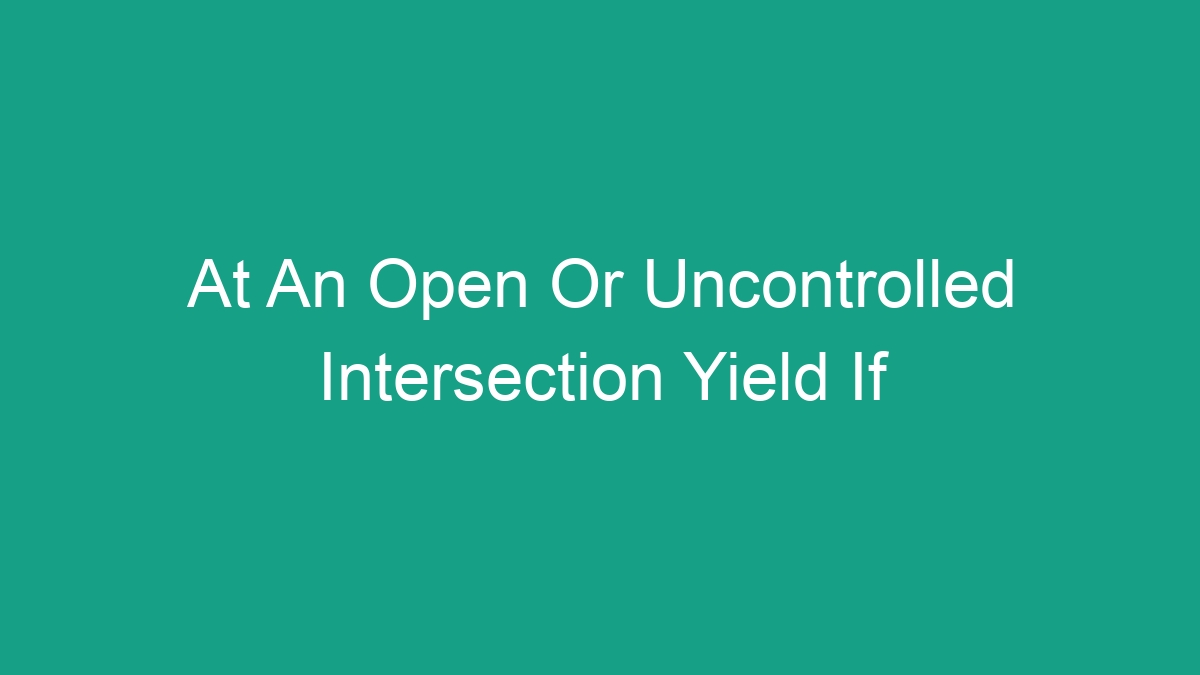
When approaching an open or uncontrolled intersection, it is crucial to understand the rules and regulations governing this type of traffic scenario. In the United States, the general rule is that drivers must yield the right of way to vehicles coming from the right at uncontrolled intersections, also known as open intersections. However, there are exceptions and additional considerations that drivers should be aware of to navigate these intersections safely and effectively.
Understanding Open or Uncontrolled Intersections
Open or uncontrolled intersections are those that do not have stop signs, yield signs, traffic lights, or any other traffic control devices to regulate the flow of traffic. These intersections rely on drivers to use their judgment and follow the rules of the road to navigate safely.
At an open intersection, vehicles approaching from different directions are required to yield the right of way to one another to avoid collisions and maintain traffic flow. This often means that drivers must be alert and prepared to stop if necessary, even if they have the right of way according to the general rules of the road.
Yield If…
When approaching an open or uncontrolled intersection, drivers should be mindful of the following situations where they are required to yield:
- Approaching from the right: The general rule at an uncontrolled intersection is that the vehicle that arrives first has the right of way. If two vehicles arrive at the same time, the vehicle on the right has the right of way. Therefore, if you are approaching the intersection and another vehicle is approaching from your right, you must yield to that vehicle.
- Entering a roadway: When entering a roadway from an uncontrolled intersection, drivers must yield to oncoming traffic. This ensures that vehicles already on the roadway have the right of way and can continue their journey without interruption.
- Pedestrians: At open intersections, drivers must yield to pedestrians who are crossing the road. This is a fundamental rule of the road that applies to all intersections, regardless of whether they are controlled or uncontrolled.
- Emergency vehicles: If an emergency vehicle with its lights and sirens activated is approaching an uncontrolled intersection, drivers must yield the right of way to allow the emergency vehicle to pass safely.
Additional Considerations
While the general rules for yielding at uncontrolled intersections are important to understand, there are additional considerations that can impact the way drivers navigate these intersections:
- Visibility: Limited visibility at open intersections can impact a driver’s ability to see oncoming traffic or pedestrians. In such cases, extra caution and reduced speed may be necessary to ensure safe navigation.
- Speed of approach: The speed at which a vehicle approaches an open intersection can affect its ability to yield effectively. Slower speeds allow for better reaction time and increased awareness of potential hazards.
- Unpredictable behavior: At uncontrolled intersections, it is essential to anticipate unpredictable behavior from other drivers or pedestrians. This could include sudden stops, unexpected lane changes, or failure to yield, requiring drivers to remain attentive and ready to react accordingly.
- Multi-lane intersections: Larger or multi-lane uncontrolled intersections can present additional challenges, as drivers may need to yield to traffic from multiple directions simultaneously. Understanding the flow of traffic and being prepared to yield as necessary is critical in these scenarios.
Conclusion
When navigating open or uncontrolled intersections, it is imperative for drivers to be aware of the rules and regulations governing the right of way. Yielding to vehicles approaching from the right, pedestrians, and emergency vehicles, as well as exercising caution in situations with limited visibility or unpredictable behavior, is crucial for safe and efficient traffic flow. By understanding and adhering to these principles, drivers can contribute to a safer and more harmonious driving experience for everyone on the road.
FAQs
Q: What should I do if two vehicles arrive at an uncontrolled intersection at the same time?
A: In this situation, the vehicle on the right has the right of way. If you are approaching the intersection and another vehicle is approaching from your right, you must yield to that vehicle.
Q: Do I always have to yield to pedestrians at uncontrolled intersections?
A: Yes, regardless of the type of intersection, drivers must yield to pedestrians who are crossing the road. This is a fundamental rule of the road that applies to all intersections, whether they are controlled or uncontrolled.
Q: How does limited visibility impact yielding at uncontrolled intersections?
A: Limited visibility at open intersections can affect a driver’s ability to see oncoming traffic or pedestrians. In such cases, extra caution and reduced speed may be necessary to ensure safe navigation.


